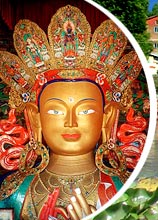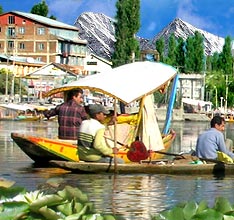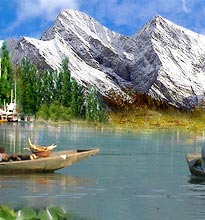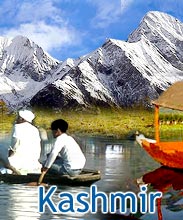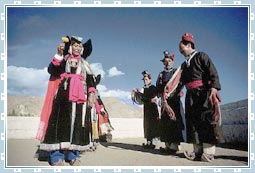 The
Buddhist influence on Ladakh culture started as early as the 7th
century. And now, this faith has gained dominance in this entire region.
All over Ladakh, you will find ancient Buddhist rock engravings, even in
the few areas dominated by Muslims. You will identify Buddhist villages
by a distance, as Mani walls customarily mark the approach to these
villages. These walls are long chest-high structures with engraved
stones opposite them. The stones are inscribed with the mantra in mane
paddle hum and by shorten, commemorative cairns, like stone pepper pots.
The
Buddhist influence on Ladakh culture started as early as the 7th
century. And now, this faith has gained dominance in this entire region.
All over Ladakh, you will find ancient Buddhist rock engravings, even in
the few areas dominated by Muslims. You will identify Buddhist villages
by a distance, as Mani walls customarily mark the approach to these
villages. These walls are long chest-high structures with engraved
stones opposite them. The stones are inscribed with the mantra in mane
paddle hum and by shorten, commemorative cairns, like stone pepper pots.One of the major highlights of the culture of Leh Ladakh are the monasteries that you will find in almost every village. They may range from huge complexes consisting of a number of shrines, prayer halls, etc to a tiny hermitage housing a single image. The other dominant faith, that of Islam, finds a presence mainly in the western areas of Ladakh. The early conversion of the sub-rulers of Drass, Kargil and the Suru Valley led to the penetration of the Shia sect in Ladakh. In the areas dominated by the Muslims, you will mainly find mosques, ranging from the small unpretentious buildings to the huge Imambaras.
Rather than rest of the Indians, the Ladakhis look more like the residents of Tibet and Central Asia, be it their physique or their facial features. Even though the original population of Ladakh consisted of Dards, an Indo-Aryan race, but large-scale immigration from Tibet changed the cultural heritage of Ladakh. The only people that resemble the mainland Indians are the Muslims, residing mainly in the Leh area. Songs and poems for every occasion, as well as local versions of the Kesar Saga (the Tibetan national epic) also form a part of Ladakh culture.

